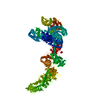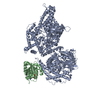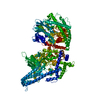+ Open data
Open data
- Basic information
Basic information
| Entry |  | |||||||||
|---|---|---|---|---|---|---|---|---|---|---|
| Title | Photorhabdus luminescens Makes caterpillars floppy (Mcf) toxin | |||||||||
 Map data Map data | Composite map used for model building | |||||||||
 Sample Sample |
| |||||||||
 Keywords Keywords |  Bacterial toxin / Bacterial toxin /  TOXIN TOXIN | |||||||||
| Function / homology | TcdA/TcdB toxin, pore forming domain / TcdA/TcdB pore forming domain /  Toxin protein Toxin protein Function and homology information Function and homology information | |||||||||
| Biological species |   Photorhabdus luminescens (bacteria) Photorhabdus luminescens (bacteria) | |||||||||
| Method |  single particle reconstruction / single particle reconstruction /  cryo EM / Resolution: 3.6 Å cryo EM / Resolution: 3.6 Å | |||||||||
 Authors Authors | Belyy A / Heilen P / Hofnagel O / Raunser S | |||||||||
| Funding support |  Germany, 1 items Germany, 1 items
| |||||||||
 Citation Citation |  Journal: Nat Commun / Year: 2023 Journal: Nat Commun / Year: 2023Title: Structure and activation mechanism of the Makes caterpillars floppy 1 toxin. Authors: Alexander Belyy / Philipp Heilen / Philine Hagel / Oliver Hofnagel / Stefan Raunser /  Abstract: The bacterial Makes caterpillars floppy 1 (Mcf1) toxin promotes apoptosis in insects, leading to loss of body turgor and death. The molecular mechanism underlying Mcf1 intoxication is poorly ...The bacterial Makes caterpillars floppy 1 (Mcf1) toxin promotes apoptosis in insects, leading to loss of body turgor and death. The molecular mechanism underlying Mcf1 intoxication is poorly understood. Here, we present the cryo-EM structure of Mcf1 from Photorhabdus luminescens, revealing a seahorse-like shape with a head and tail. While the three head domains contain two effectors, as well as an activator-binding domain (ABD) and an autoprotease, the tail consists of two putative translocation and three putative receptor-binding domains. Rearrangement of the tail moves the C-terminus away from the ABD and allows binding of the host cell ADP-ribosylation factor 3, inducing conformational changes that position the cleavage site closer to the protease. This distinct activation mechanism that is based on a hook-loop interaction results in three autocleavage reactions and the release of two toxic effectors. Unexpectedly, the BH3-like domain containing ABD is not an active effector. Our findings allow us to understand key steps of Mcf1 intoxication at the molecular level. | |||||||||
| History |
|
- Structure visualization
Structure visualization
| Supplemental images |
|---|
- Downloads & links
Downloads & links
-EMDB archive
| Map data |  emd_17440.map.gz emd_17440.map.gz | 10.3 MB |  EMDB map data format EMDB map data format | |
|---|---|---|---|---|
| Header (meta data) |  emd-17440-v30.xml emd-17440-v30.xml emd-17440.xml emd-17440.xml | 16.2 KB 16.2 KB | Display Display |  EMDB header EMDB header |
| Images |  emd_17440.png emd_17440.png | 64.6 KB | ||
| Filedesc metadata |  emd-17440.cif.gz emd-17440.cif.gz | 7.2 KB | ||
| Others |  emd_17440_additional_1.map.gz emd_17440_additional_1.map.gz | 124.9 MB | ||
| Archive directory |  http://ftp.pdbj.org/pub/emdb/structures/EMD-17440 http://ftp.pdbj.org/pub/emdb/structures/EMD-17440 ftp://ftp.pdbj.org/pub/emdb/structures/EMD-17440 ftp://ftp.pdbj.org/pub/emdb/structures/EMD-17440 | HTTPS FTP |
-Related structure data
| Related structure data |  8p52MC  8p50C  8p51C C: citing same article ( M: atomic model generated by this map |
|---|---|
| Similar structure data | Similarity search - Function & homology  F&H Search F&H Search |
- Links
Links
| EMDB pages |  EMDB (EBI/PDBe) / EMDB (EBI/PDBe) /  EMDataResource EMDataResource |
|---|
- Map
Map
| File |  Download / File: emd_17440.map.gz / Format: CCP4 / Size: 236.7 MB / Type: IMAGE STORED AS FLOATING POINT NUMBER (4 BYTES) Download / File: emd_17440.map.gz / Format: CCP4 / Size: 236.7 MB / Type: IMAGE STORED AS FLOATING POINT NUMBER (4 BYTES) | ||||||||||||||||||||||||||||||||||||
|---|---|---|---|---|---|---|---|---|---|---|---|---|---|---|---|---|---|---|---|---|---|---|---|---|---|---|---|---|---|---|---|---|---|---|---|---|---|
| Annotation | Composite map used for model building | ||||||||||||||||||||||||||||||||||||
| Projections & slices | Image control
Images are generated by Spider. generated in cubic-lattice coordinate | ||||||||||||||||||||||||||||||||||||
| Voxel size | X=Y=Z: 0.9 Å | ||||||||||||||||||||||||||||||||||||
| Density |
| ||||||||||||||||||||||||||||||||||||
| Symmetry | Space group: 1 | ||||||||||||||||||||||||||||||||||||
| Details | EMDB XML:
|
-Supplemental data
-Additional map: DeepEMhanced composite map
| File | emd_17440_additional_1.map | ||||||||||||
|---|---|---|---|---|---|---|---|---|---|---|---|---|---|
| Annotation | DeepEMhanced composite map | ||||||||||||
| Projections & Slices |
| ||||||||||||
| Density Histograms |
- Sample components
Sample components
-Entire : Photorhabdus luminescens Makes caterpillars floppy (Mcf) toxin
| Entire | Name: Photorhabdus luminescens Makes caterpillars floppy (Mcf) toxin |
|---|---|
| Components |
|
-Supramolecule #1: Photorhabdus luminescens Makes caterpillars floppy (Mcf) toxin
| Supramolecule | Name: Photorhabdus luminescens Makes caterpillars floppy (Mcf) toxin type: complex / ID: 1 / Parent: 0 / Macromolecule list: all |
|---|---|
| Source (natural) | Organism:   Photorhabdus luminescens (bacteria) Photorhabdus luminescens (bacteria) |
-Macromolecule #1: Toxin protein
| Macromolecule | Name: Toxin protein / type: protein_or_peptide / ID: 1 / Number of copies: 1 / Enantiomer: LEVO |
|---|---|
| Source (natural) | Organism:   Photorhabdus luminescens (bacteria) Photorhabdus luminescens (bacteria) |
| Molecular weight | Theoretical: 329.440219 KDa |
| Recombinant expression | Organism:   Escherichia coli (E. coli) Escherichia coli (E. coli) |
| Sequence | String: MGSSHHHHHH SSGLVPRGSH SEQKLISEED LSMASISKDF TNLLNTLIDG QIGAASRQTE WFNMSPDERT DYIKQVDERL QEMQQSTLS VLAAQHFQMQ DNPVSVGDQL QTLQKRRQQM TDVPGTPAIN AYKQQLDRDI LLYRRQQTAM THFDSTWRKV L VMLGPDDS ...String: MGSSHHHHHH SSGLVPRGSH SEQKLISEED LSMASISKDF TNLLNTLIDG QIGAASRQTE WFNMSPDERT DYIKQVDERL QEMQQSTLS VLAAQHFQMQ DNPVSVGDQL QTLQKRRQQM TDVPGTPAIN AYKQQLDRDI LLYRRQQTAM THFDSTWRKV L VMLGPDDS KPLNATTLRE NAVDKQAKLD TEIKRLEQQL TIQVADSTFS QKYVTLFSEL QAYKDVNARY NALLKASATE EA AALGALT KVPQASDDLP VNISLLMMEE RPGYIRMNVA LVNASTDGRF KDFFLENGRL VVLTDGVLNF SFGTAARSLA WQQ QYRLKS EPPSFRSPTY TPIRSVLVKT EFVEKYFANY LVSESTLRGG FKAQLLGNGR KMLLTSVDRK VPNQIGIQVS GQAP NTTIT REVPLASALS DLINQNADIA SFRTIGLEGF RQSSYHPDRD GLFVNIHELE RSVGFAGRQY LLEMPQDNDY LSATP FGVM SVDGDKVSSS HLSKAQTDTL YQYNAAFFEK LEQLRSGGMK ASRLFEGSIE RTAFVQQLVR LLERNHITPA GVLAPE YPR DNMRDIKGNN LNKVLWEQAF AASVWRSRDN DPLLFRLATR LVKNPAVVKV LQNGYVQSDI AQARELLAPL YEQWRTR AV EAETQRVASA NAAQHPSNPK VHVFDQAEVE RSLDDKLLIL LLTGPQSLEG TDVQLRPMVE AALLSNEGRS LRKQILFH A LRPVADSFSK AAAPVNPHAE LGVGKIMINN RLNQPDPYLI LNTSSEEQAY RDGSYLIKDD KYRSYNQFRP DFKNDATRY MNDLDTPFVG GISGTTQTVS NVLTELFGGA LSVKQYWQFQ MANAAFMIRN GYHSFFETFY VAARYEPEGA DSIGKEMLQM FDKYRVEGS KKALQGKLYD GVMARVLPII NQGLSAADEF HPPRFTRIGP RPALLGQAVK DLELKAGLTS VGDGFEPRQG S ADIHQFVT DPVLFAKTHT VSAEALVRSG RLPAEGSAQL VKVGSGLYEL EYTEQSANDI SSSSIPAYFL GYNGPNQANA VP AYVDIPK RTIAGNFLFT GTLSGGSLVV TSLDANTFRV YHDGRVNSSL LYDNVVMAVD YKDYQIAGTA EGLAAAYMQY VNH EWQLVL QRQEYQRDGQ MLRLRLRDDE EPLSIQVADS QVVERNQAQF VAYREQIHQQ LKKVATQFEV SISGVSDGVY TEGE FSPDH PAIAAWAKLC AEVYDRINAD TKQLVDKRNK LYENRRNTIR RDLINQQIKQ LNITLEYYKA QYDTVLREAG FVEQS WLWQ QIKAKNGSAA VVRIDDTAIQ GGGKQRTDSV GERYAISEAY QRGARGTGFS DGLRNFREIE IPGVDDKMSA LEMKRL FLE GKLTSEQQGA LSGRITETSR AEYIDKVLRQ TAVFSEDFHD AGSVFDRLVP QDFYLSLVGD RSGGRCYPLV RAMTVAL AS GGEAGINSLV QKLFFASADP QAGSSTLLRN SLIKLHSNVE AVQASTELGQ FGLSEVVSRL AATTGTSMFA LNTQNHSM M VGSTVTTEGR RYYFYDPNVG IFAFDNTKSL SRAMEQHLVG RRLAVHYGSF GSKSAPAFNL IEIDTGKMAE VPVGNGLNV ADLTRFEELS SVIGQRRQVE QVMSAQERIT EDLQLSTALQ AFDAEQWGAR FEAASTRLAQ EHQLDSRWLP IIATTEEQGE GRYRVQFIN RDQPEQTRWL DTDDSTFVEF RRFVDEHMSV LNEHFTLESG RMRPRGGVGE AAPVDGLNAG FAVQALIQWF S DKNRHDAA NGMASPDLAT ALKVHSYLNF VQMVHGGVQD VIKVTALVRT ALRGEVVAAQ TSFKEFALSL GHTVNEGVGV LF GGAMIGL DAYELAHAEN DVQKAVFGTQ LAFDSASFVT GAAGIGAGLV GASTAGAVLG GAGVILGGLA VGFTALAQAF GAV AEDAKA VGRYFDTVDK AYKGNGYRYD NEKQVLVPLA GAVIKTLDLS KNQIDFDSQY IYRTHSGSTG SGKINYFFWV GDFP RMVHD RGQAIEVRSG IGYKDVSRPL EHGDSNVVIL PGTPKSYISY EYMLLPGATT RHDAGFDVIR RLEEDKRFDY DFYIF PGEE TIRRIHHEYV DTPIEVVLDQ RNRQLVAPEL PKELHGFLCY EIKGAGGEYL IGLNEGAKVN LTSDVASTWI IDSSQL ASD SISVSKDQLL VGEKGKEVVV KLYLAQNSQV LVVNGKGEVR KVDFTSLTAQ VISEDASKWQ VPGQQIEQHL SDLAKAH QL HGQYVVVENY RHQGRDVGRA FYDVTKDRML FTDTTNEQAK RAQLGAVMGD YAYFYDADNA VAWRVDIATG QVDAQFEP W FNQNAGHISR FWQEGDVVYL ARRYRLKERE AELGYRIIGD RMELVSAVGD DALLQLSARI GRHGDELEAI LQGYRSNST QRGTLMYTLG ARLIQPTSAA LVTVFGVDAA GVPHRYWIRT SDGTLIKPNL APPADQTLHF EAHEQTRSAW QIPADLVLAG SMPLLGGKE VFFFYSKEQK TLFRQEGPGQ EVLDANQPSA LRVTTPALTN VINLNGHLVV VTEDGRVARL DALGQLSYAA V NEHWLKGR IHWWQDLTSV TDGRATLAVF GVKDTDGKSL LPVWYHNGQV VVASAALQDK HPQFLGFEVD GSSARLFEPA SG KLYRQPA MTADALAAAF GTDEVLEASA QLPAANELEP ELHLKAAEQV DAGLRLTTVK GEILLRTHDG KLQLVAVDKD WQQ DNLVRL SQALAEVAGQ WRVKGVLTLQ GDDTQGWFDV GSGQVFSIGG IPATDNLRFI GIAVGKKGAY VYNPTDQMLY QVKE SGAQK LNHYADVERI GSSLLLQDGG KGDLSPMLIA GVDSVVLHGG AGSDTYRLSQ TMWSYYRTVV IDNDDPNQVL DRLII LAVD AEKIFVSRHE DDLMLTDSVN GTVLVIRKVF GSQAVTHRHL QIDLEGSSSV ISVDHLVKGF TRLGTANIGL FELPWA IEL DYKDDDDK UniProtKB:  Toxin protein Toxin protein |
-Experimental details
-Structure determination
| Method |  cryo EM cryo EM |
|---|---|
 Processing Processing |  single particle reconstruction single particle reconstruction |
| Aggregation state | particle |
- Sample preparation
Sample preparation
| Buffer | pH: 8 |
|---|---|
| Grid | Model: C-flat-2/1 / Material: COPPER / Mesh: 400 |
| Vitrification | Cryogen name: ETHANE / Chamber humidity: 100 % / Instrument: FEI VITROBOT MARK III |
- Electron microscopy
Electron microscopy
| Microscope | FEI TITAN KRIOS |
|---|---|
| Electron beam | Acceleration voltage: 300 kV / Electron source:  FIELD EMISSION GUN FIELD EMISSION GUN |
| Electron optics | Illumination mode: SPOT SCAN / Imaging mode: BRIGHT FIELD Bright-field microscopy / Nominal defocus max: 2.5 µm / Nominal defocus min: 1.0 µm Bright-field microscopy / Nominal defocus max: 2.5 µm / Nominal defocus min: 1.0 µm |
| Image recording | Film or detector model: GATAN K3 (6k x 4k) / Number grids imaged: 2 / Number real images: 21741 / Average electron dose: 70.0 e/Å2 |
| Experimental equipment |  Model: Titan Krios / Image courtesy: FEI Company |
- Image processing
Image processing
| Startup model | Type of model: NONE |
|---|---|
| Initial angle assignment | Type: MAXIMUM LIKELIHOOD / Software - Name: SPHIRE |
| Final angle assignment | Type: MAXIMUM LIKELIHOOD / Software - Name: SPHIRE |
| Final reconstruction | Resolution.type: BY AUTHOR / Resolution: 3.6 Å / Resolution method: FSC 0.143 CUT-OFF / Software - Name: SPHIRE / Number images used: 363044 |
-Atomic model buiding 1
| Refinement | Space: REAL / Protocol: AB INITIO MODEL |
|---|---|
| Output model |  PDB-8p52: |
 Movie
Movie Controller
Controller










 Z (Sec.)
Z (Sec.) Y (Row.)
Y (Row.) X (Col.)
X (Col.)




























